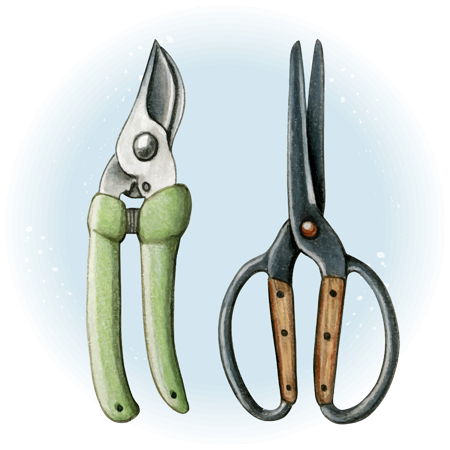Salvia Small Talk: Deadheading Herbaceous Rosette-Growing Salvias

Removing withered Salvia blossoms that are beginning to go to seed is called deadheading — a form of pruning. This is trimming done in late spring and summer to make plants look tidier and encourage repeat blooming during the growing season. How to deadhead a Salvia depends on its form of growth, which may be one of four types: Rosette-growing herbaceous perennial; soft-stemmed deciduous or semi-evergreen sage; deciduous, woody-stemmed sage; or evergreen shrub. Many Salvias in each of these categories can thrive as annuals in areas where winters are too cold for perennial growth. Deadheading increases bloom for your buck, especially for sages grown as annuals.
The growing pattern of some Salvias begins with a rosette — a whorl of leaves at the base of a plant. Some rosette-forming sages produce only soft, herbaceous foliage that dies to ground in autumn. These plants have flower spikes that may become thick but never woody.
Herbaceous, rosette-growing Salvias may remain erect throughout the growing season or become lax — particularly in partial shade — and sometimes develop a trampled-down look at the center of the plant as if an animal bedded there overnight.
These sages can be found around the world in native habitats including fields, meadows, slopes (some rocky), and woodlands. Among the European meadow sages, some of the most popular kinds are Blue Mountain (Blauhugel), Caradonna, May Night (Mainacht), and many kinds of Clary. Here are some less familiar herbaceous rosette Salvias grown at Flowers by the Sea Farm and Online Nursery:
- Balkan Sage (Salvia forsskaolii) from the Balkan Peninsula
- Dandelion Leaf Sage (Salvia taraxafolia) from the Atlas Mountains of Morocco
- Romanian Sage (Salvia transsylvanica) from Romania and Russia, and
- Wild Meadow Sage (Salvia x sylvestris ‘Wild Form’) from Europe.
Deadheading flowers like daisies or roses involves removing individual blossoms one by one from stems. But that process would be too time consuming for herbaceous, rosette-forming sages, which have flower spikes covered with a multitude of miniscule-to-small flowers. The best way to remove their spent blossoms is to snip whole spikes with sharp, lightweight bypass pruners (secateurs). Cut them to about two or three inches tall to nurture tiny leaf buds on the spikes while also giving new base foliage a chance to emerge.
If time allows and there are still some flower spikes blooming, be selective about what you trim. Leave some to feed the bees and hummingbirds, then remove those spikes on a second go-round when they fade.
Questions and More Information
The plant description pages in our online catalog contain a wealth of information about plant characteristics and needs. Page features include a button saying, “How to Prune this Plant.” It leads to a pop-up box identifying the plant’s form of growth and basic information about pruning.
If you have more questions about pruning or any of the plants we grow, please contact us. We’re glad to listen and share what we know.

 Salvia forsskaolii
Salvia forsskaolii  Salvia taraxacifolia
Salvia taraxacifolia  Salvia transsylvanica
Salvia transsylvanica  Salvia x sylvestris 'Wild Form'
Salvia x sylvestris 'Wild Form'
Comments
There are no comments yet.